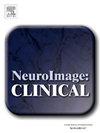肌萎缩性侧索硬化症的早期皮质改变和神经心理学机制
IF 3.4
2区 医学
Q2 NEUROIMAGING
引用次数: 0
摘要
目的探讨肌萎缩性侧索硬化症(ALS)患者皮层结构和功能改变的特点及其对情绪和认知功能的调节,并探讨其对早期ALS的诊断价值。方法对59例ALS患者(28例为ALS 1型,31例为ALS 2型,采用King 's College分期)和31例健康对照者进行多参数MRI、运动和神经心理评估及血清神经丝轻链(NfL)水平评估。进行中介分析以检验皮层改变如何影响情绪和认知功能之间的关系。构建支持向量机(SVM)分类模型来评估皮质差异参数的诊断效用。结果als 1患者表现出皮层厚度(CT)增加,扣带区和额颞叶区功能活动增加,与神经心理表现和NfL水平相关。中介分析显示,颞叶和额颞叶功能活动显著调节抑郁症状与认知功能的关系。支持向量机分类表明,结合低频波动幅度(ALFF)模型的改变区取得了稍好的效果(AUC = 0.853, 95% CI: 0.687-1.000, p <;0.001)与CT (AUC = 0.779, 95% CI: 0.587-0.972, p <;0.001),尽管两种模型在区分ALS 1和ALS 2组方面的疗效有限。结论ALS患者的大脑结构和功能改变介导了抑郁症对认知功能的影响,为该疾病的神经心理学机制和早期诊断的潜在生物标志物提供了新的见解。本文章由计算机程序翻译,如有差异,请以英文原文为准。
Early cortical alterations and neuropsychological mechanisms in amyotrophic lateral sclerosis
Objective
This study investigates the characteristics of cortical structural and functional alterations in amyotrophic lateral sclerosis (ALS) patients and their modulation of emotional and cognitive functions, as well as to discuss their diagnostic value in early-stage ALS.
Methods
Fifty-nine ALS patients (28 in ALS 1 and 31 in ALS 2, categorized using King’s College Staging) and 31 healthy controls were evaluated using multiparametric MRI, motor and neuropsychological assessments, and serum neurofilament light chain (NfL) levels. Mediation analyses were performed to examine how cortical alterations influence the relationship between emotional and cognitive functions. Support vector machine (SVM) classification models were constructed to assess the diagnostic utility of differential cortical parameters.
Results
ALS 1 patients exhibited increased cortical thickness (CT) and functional activity in the cingulate and frontotemporal regions, correlating with neuropsychological performance and NfL levels. Mediation analysis revealed that perigenual and frontotemporal functional activity significantly modulated the relationship between depressive symptoms and cognitive function. SVM classification showed that the combined altered regions with Amplitude of Low Frequency Fluctuations (ALFF) model achieved slightly better performance (AUC = 0.853, 95 %CI: 0.687–1.000, p < 0.001) compared to CT (AUC = 0.779, 95 %CI: 0.587–0.972, p < 0.001), although both models showed limited efficacy in differentiating between ALS 1 and ALS 2 groups.
Conclusions
Cortical structural and functional alterations in ALS mediate the impact of depression on cognitive function, offering insights into the neuropsychological mechanisms of the disease and potential biomarkers for early-stage diagnosis.
求助全文
通过发布文献求助,成功后即可免费获取论文全文。
去求助
来源期刊

Neuroimage-Clinical
NEUROIMAGING-
CiteScore
7.50
自引率
4.80%
发文量
368
审稿时长
52 days
期刊介绍:
NeuroImage: Clinical, a journal of diseases, disorders and syndromes involving the Nervous System, provides a vehicle for communicating important advances in the study of abnormal structure-function relationships of the human nervous system based on imaging.
The focus of NeuroImage: Clinical is on defining changes to the brain associated with primary neurologic and psychiatric diseases and disorders of the nervous system as well as behavioral syndromes and developmental conditions. The main criterion for judging papers is the extent of scientific advancement in the understanding of the pathophysiologic mechanisms of diseases and disorders, in identification of functional models that link clinical signs and symptoms with brain function and in the creation of image based tools applicable to a broad range of clinical needs including diagnosis, monitoring and tracking of illness, predicting therapeutic response and development of new treatments. Papers dealing with structure and function in animal models will also be considered if they reveal mechanisms that can be readily translated to human conditions.
 求助内容:
求助内容: 应助结果提醒方式:
应助结果提醒方式:


